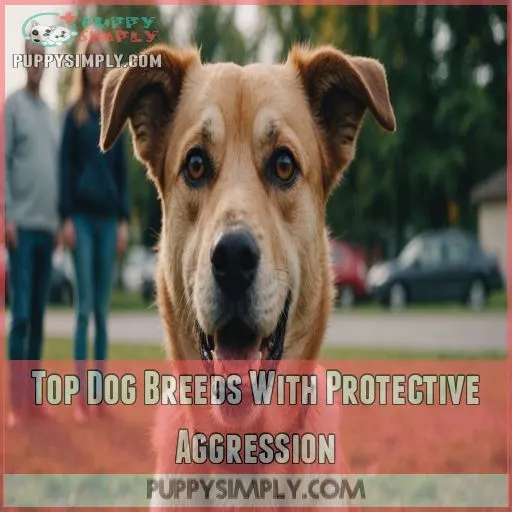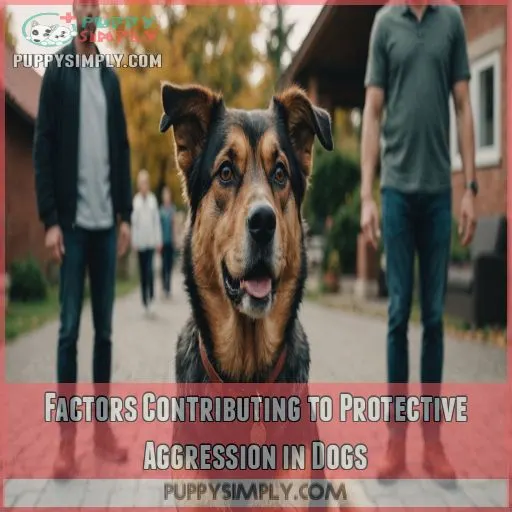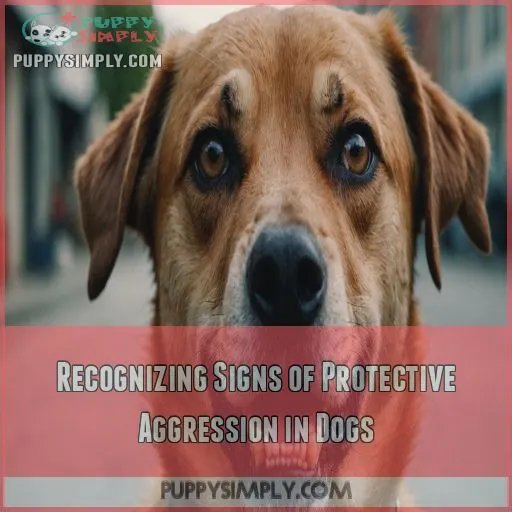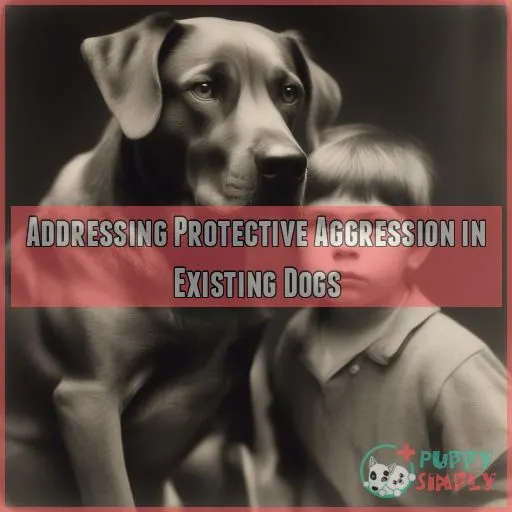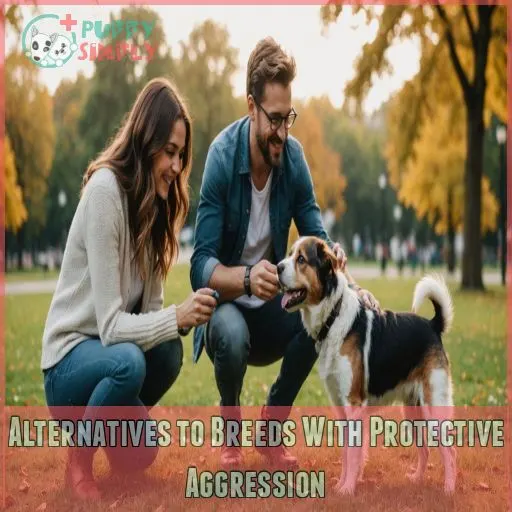This site is supported by our readers. We may earn a commission, at no cost to you, if you purchase through links.
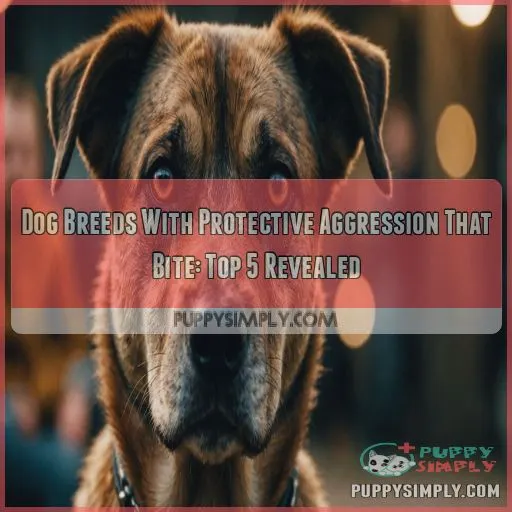
However, don’t judge a book by its cover! early socialization and positive reinforcement can turn these formidable protectors into affectionate companions. Imagine your dog as a superhero – mighty yet understanding with the right guidance.
While their powerful instincts might lead to some "misunderstandings," especially when feeling threatened, responsible ownership and consistent training keep them in check.
Table Of Contents
- Key Takeaways
- Top Dog Breeds With Protective Aggression
- Factors Contributing to Protective Aggression in Dogs
- Recognizing Signs of Protective Aggression in Dogs
- Consequences of Protective Aggression in Dog Breeds
- Prevention Strategies for Protective Aggression Bites
- Addressing Protective Aggression in Existing Dogs
- Alternatives to Breeds With Protective Aggression
- Frequently Asked Questions (FAQs)
- Conclusion
Key Takeaways
- Early Socialization is Crucial: Just like you wouldn’t skip a good breakfast, don’t skip early socialization for your pup. Introduce them to a variety of people and pets, so they don’t become the neighborhood’s barking mystery. Start early and sprinkle positive vibes like treats.
- Training is Your Best Friend: Forget the superhero cape; consistent training is what turns your dog into a gentle guardian. Use positive reinforcement to teach them that being calm and friendly pays off more than growling at the mailman.
- Understand Your Dog’s Instincts: Think of your dog as having a built-in alert system. They’re not out for world domination; they just need guidance to know when to chill. Tap into their instincts with understanding, not assumptions.
- Be Aware of Breed-Specific Challenges: Owning a dog breed with protective instincts isn’t like adopting a goldfish. Be ready for potential legal and insurance hurdles. Know your local laws to keep your furry friend safe and your wallet out of hot water.
Top Dog Breeds With Protective Aggression
If you’re exploring dog breeds known for protective instincts, you’ll find fascinating creatures like Pit Bulls, Rottweilers, and German Shepherds on the list.
These fur-babies can be both loving and a bit overzealous in their guarding duties, sometimes making them a handful — but hey, who doesn’t appreciate a friend who’s got your back?
Pit Bulls and Their Protective Instincts
As a Pit Bull owner, you know these pups have a reputation for being protective. But with the right training and socialization, your Pit Bull can be a loyal, loving companion. Key is understanding their instincts:
- Pit Bulls were bred for strength and guarding
- They’re highly intelligent and keen to please
- Early socialization is essential to curb aggression
- Positive reinforcement training works best for this breed
Rottweilers as Powerful Guard Dogs
Rottweilers’ protective aggression and impressive build make them natural guardians, but with great power comes great responsibility! Their temperament needs careful management due to potential training challenges and legal liability. Owners should steer clear of breed stereotypes, focusing on understanding and training. Here’s some key info:
| Characteristic | Details | Importance |
|---|---|---|
| Temperament | Alert | High |
| Exercise | Essential | High |
| Training | Must-do | Essential |
| Legal | Know-how | Important |
German Shepherds’ Defensive Nature
German Shepherds often steal the show with their love for loyal service.
They’re known as protectors, but without proper training and socialization, these herders might express fear aggression.
Owners play an active role in shaping temperament, as stereotypes don’t define them.
Watch out for dominant aggression—their reputation as dog breeds with protective aggression that bite isn’t all bark and no bite.
Doberman Pinschers’ Loyalty and Aggression
Dobermans are like that overprotective friend you’d want by your side in a pickle.
Renowned for their loyalty and sharp intelligence, they take "having your back" to heart.
Properly training Dobermans can mitigate their protective aggression, but remember: they’re not the dangerous dog breeds stereotypes suggest.
Owning one means understanding Doberman temperament and ensuring they’re socialized early.
Chow Chows’ Dominant Personality
Chow Chows are known for their dominant personalities – they can be stubborn, aloof, and wary of strangers.
These fluffy pups require early socialization and firm, consistent training to curb their territorial tendencies.
With the right owner, Chow Chows can make loyal, protective companions.
But their aggressive streak means they’re not the best choice for first-time dog parents.
Siberian Huskies’ Territorial Behavior
Siberian Huskies are a bit like those quirky roommates with a double-lock deadbolt fascination—they can be territorial!
Want to keep your Husky’s territorial tendencies in check? Try these:
- Secure fences to prevent escape routes.
- Early training helps shape good behavior.
- Supervise their time around children and strangers.
- A temperament test can indicate any underlying issues.
After all, understanding leads to peace!
Factors Contributing to Protective Aggression in Dogs
If you’ve ever wondered why certain dog breeds are more protective and prone to biting, you’re not alone.
Genetics, socialization, and training play big roles in shaping a dog’s protectiveness,
so understanding these can help you avoid those unwanted "surprise hugs" from your furry friend!
Genetic Predisposition to Aggression
Genetics can be a wildcard when it comes to dogs.
Some breeds carry a genetic predisposition to aggression, which might put you in the doghouse if a bite claim arises.
It’s a "nature vs. nurture" tug-of-war.
Responsible breeding helps curb this trait, reducing lawsuits and scary dog bite statistics.
Choose wisely, ensuring ethical ownership and peace of mind.
Early Socialization and Its Impact
Proper socialization from an early age is really important for preventing protective aggression in dogs.
Introduce your pup to a variety of people, animals, and environments to build confidence and curb fear-based reactions.
Four key tips:
- Start socialization as early as 8 weeks old
- Gradually expose your dog to new sights, sounds, and experiences
- Use positive reinforcement to reward calm, friendly behavior
- Avoid forcing interactions that make your dog uncomfortable
Environmental Triggers for Protective Behavior
If you’re trying to figure out what might trigger protective behavior in dogs, keep an eye out for loud noises, unfamiliar people, and anything encroaching on their territory.
Food guarding is common, especially if children are around.
You’re juggling a circus of potential triggers! Be aware—these situations could lead to a dog bite claim, dog liability issues, or even a lawsuit.
Owner’s Role in Encouraging Protective Aggression
Some owners inadvertently stir the pot of protective aggression without even realizing it. Showering affection only for guarding behaviors or choosing a breed known for territorial traits reinforces such tendencies.
Understand the balance between protection and aggression, and consider the importance of early socialization to prevent dog bite claims like those discussed here.
Training Methods and Their Influence
Training methods shape a dog’s behavior in lasting ways, as demonstrated by this helpful guide.
Consistency matters.
Consider these steps to manage protective aggression:
- Use positive reinforcement to encourage desired actions.
- Avoid punishment methods that can escalate aggression.
- Start early training to build trust and understanding.
- Remember, owner influence plays a pivotal role in responsible dog ownership.
Each step reduces dog bite claims and makes for a safer environment.
Recognizing Signs of Protective Aggression in Dogs
Recognizing the signs of protective aggression in your dog is really important for keeping everyone safe.
Look out for body language cues, vocal warnings, and escalating behavior – knowing what to watch for can help you nip any aggressive tendencies in the bud.
Body Language Indicating Aggressive Behavior
Spotting a dog’s aggressive body language helps you stay safe and in control. Watch for tail-tucking, stiffening, or piloerection, each a red flag waving in the wind. Like Sherlock uncovering clues, you must gather evidence. Stay calm, and you can sometimes avoid the dog’s bite.
Aggressive body language is a critical sign of a dog’s potential aggression, and understanding canine body language can help prevent fights between dogs in the same household.
| Signals | Description |
|---|---|
| Tail-tucking | Fear or submission |
| Stiffening | Potential aggression |
| Piloerection | Raised hackles, tension |
Vocal Cues and Warning Signs
You never want to ignore the vocal cues dogs give.
A growl here, a whimper there—these are vocal warning signs that a bite might be on the horizon.
Keep an ear out for these indicators:
- Growling: It’s often a clear warning signal.
- Whining: Your dog might be feeling stressed.
- Barking: A sure sign of discomfort.
Stay alert and seek dog bite claim legal assistance if needed!
Escalation Patterns in Protective Dogs
Listening to your dog’s vocal cues can be like hearing whispers in a crowded room.
Once deciphered, they guide you through escalation patterns.
Dogs escalate from stress triggers like a tight spring, starting with warning growls and tense body language.
Before you know it, they’re in full defense mode—a potential dog bite claim’s legal impact comes faster than you’d expect.
Differentiating Between Playful and Aggressive Behavior
It’s not always easy to tell if a dog’s behavior is playful or aggressive. Look for telltale signs – a wagging tail and relaxed body language usually signal play, while a stiff, upright posture, growling, and snapping teeth indicate aggression. Pay attention to the context too – is the dog feeling threatened or just being silly?
Body language can be a big indicator.
- Tail wags vs. growls
- Playful nips vs. bites
- Body language cues
- Ear position
Context matters – is the dog feeling threatened or just being silly?
Consequences of Protective Aggression in Dog Breeds
You might love your protective pooch, but their tendency to bite can lead to costly legal and safety issues.
Breed-specific laws might not be on your side, and insurance companies could treat your household like it’s trying to adopt a porcupine.
Legal Implications of Dog Bites
Dog bite lawsuits can be a real headache.
Strict liability means owners often foot the bill, especially if their dog has a reputation for being a biter!
Invest in liability insurance, folks.
Some breeds face restrictions, so check local laws before your pooch lands you in hot water.
Impact on Public Safety and Perception
Public perception of protective dog breeds can be as tricky as a cat on a hot tin roof.
These breeds often face scrutiny.
- Media portrayal skewing incidents.
- Safety concerns fueling fear.
- Legal liability challenging owners with dog bite claim legal issues.
Breed-Specific Legislation and Restrictions
Oftentimes, communities enact breed-specific legislation to address public safety concerns over aggressive dog breeds.
These laws may ban certain breeds outright, require muzzles, or impose additional regulations.
While controversial, such measures aim to reduce dog bite incidents and protect citizens.
As a responsible owner, it’s important to research your local laws before getting a dog.
Insurance Challenges for Aggressive Breed Owners
Owning breeds with protective aggression can give your wallet more bite than you bargained for. Insurance premiums might skyrocket, and you’ll face breed restrictions or policy denial.
Liability concerns often lead to legal disputes.
Consider pet liability insurance to dodge dog bite claim legal trials to protect your finances.
Enjoy the love of dog ownership without turning a blind eye to potential headaches.
Prevention Strategies for Protective Aggression Bites
When dealing with protective dog breeds, it’s really important to use strategies like proper socialization and positive reinforcement to avoid aggressive incidents.
Ensuring your dog’s interactions are managed well can keep your shoes safe from becoming the next chew toy!
Proper Socialization Techniques for Aggressive Breeds
Facing legal consequences from dog bites can be stressful.
Early socialization is your first line of defense.
Puppy classes and controlled exposure to varied environments can work wonders to reduce fear.
It’s like building a social media profile for your dog!
Ensuring dog insurance covers potential claims adds peace of mind, avoiding dog bite claim legal failures. Having your dog checked by a vet before introducing them to a bearded dragon is essential for safety.
Positive Reinforcement Training Methods
Positive reinforcement training is key for aggressive breeds.
Reward your pup with treats and praise when they exhibit calm, non-aggressive behaviors.
Consistency is essential – use the same commands and reward system every time.
Proper timing is important too; reward the instant they do something right.
This builds confidence and trust, reducing the risk of protective bites.
Managing Interactions With Strangers and Other Dogs
Interacting with strangers and other dogs can feel like figuring out a puzzle. When managing these encounters, consider these gems:
- Stranger Introductions: Use treats for distraction and safe greetings.
- Dog Park Etiquette: Pay attention to body language cues.
- Leash Reactivity: Calm walks can ease tension.
- Legal Duties: Know dog bite claim legal judgment essentials.
Stay mindful, avoiding dog bite claim legal enforcement pitfalls!
Creating a Safe Environment for Protective Dogs
Creating a safe, secure space for your protective dog is like building a fortress, minus the drawbridge.
Secure fencing is essential to prevent Houdini-like escapes and create a dog-friendly yard.
Positive reinforcement and training consistency encourage good behavior.
Your dog’s castle should be comfortable, not confining. This approach keeps everyone safe and gives peace of mind, reducing any potential dog bite claims.
Addressing Protective Aggression in Existing Dogs
Protective behavior in dogs can sometimes extend to seemingly harmless individuals, like the family postman.
Behavior modification techniques, along with tools such as medication and rehoming, can be used to manage or even reduce aggressive behavior like those seen in English Bulldogs.
Professional Behavior Modification Techniques
If your pup’s protective instincts have gone overboard, don’t worry – professional trainers can help.
They’ll use positive reinforcement to reshape your dog’s behavior, rewarding calm responses and gradually exposing them to triggers in a controlled setting.
With patience and the right techniques, you can curb that aggressive streak for good.
Desensitization and Counterconditioning Approaches
Taming your dog’s protective aggression is like defusing a ticking time bomb. Use desensitization and counterconditioning approaches to transform that growl into a wag. Here’s how:
- Gradual exposure to triggers
- Reinforce positive behaviors
- Pair scary things with treats
- Keep sessions short and sweet
- Patience, it’s a virtue
Rome wasn’t built in a day, and neither is a calm dog.
Medication Options for Aggressive Dogs
When dealing with aggressive dogs, medication can be a game-changer.
It might not be a walk in the park, but it helps control behavioral issues.
However, every silver lining has a cloud—medication side effects are possible.
Pairing pills with behavioral therapy and owner education can boost drug effectiveness and make sure ethical considerations are front and center.
Rehoming Considerations for Unmanageable Cases
Considering medication for your dog’s aggression leads to thoughts about the rehoming process. Sometimes, it’s the best choice.
Look into shelter options that prioritize safety. Know the legal implications so nobody gets in hot water.
Think about your owner responsibility and ethical considerations; finding a loving environment might be the ticket. Remember, a diamond sometimes fits better in a different setting.
Alternatives to Breeds With Protective Aggression
If you’re wary of aggressive dog breeds, don’t worry – there are plenty of non-aggressive alternatives that can still make great guard dogs.
From mixed breeds to breeds specifically chosen for their gentle temperaments, you have options that can provide security without the risk of bites.
Non-Aggressive Breeds With Guard Dog Qualities
If your current dog is a little too aggressive for comfort, you might be exploring other options.
Consider breeds with guardian instincts but a calm temperament.
Think Labradors or Golden Retrievers; they’re family dog material with a balance of training for safety.
They prioritize love over war, understanding fear vs. protection, and can offer peace of mind.
Mixed Breeds and Their Temperament Benefits
So, you’re scouting for the perfect furry friend without the protective drama? Mixed breeds offer a jackpot of hybrid vigor, often blending sweet-natured traits with a twist of uniqueness.
They skip some health issues tied to specific breeds, although they’ve got a dash of unpredictability too.
Choosing one is like unwrapping a mystery gift that keeps on wagging!
Choosing Dogs Based on Individual Temperament
Selecting a dog based on individual temperament rather than breed stereotypes makes sure a furry companion that meshes well with your lifestyle.
Responsible breeders offer temperament testing to match personalities.
Don’t judge a book by its cover—or a dog by its breed!
Adoption considerations are important.
Choose a pup that fits like a glove through individual evaluation. Your future self will thank you!
Professional Security Options Vs. Aggressive Dogs
Rather than relying on an aggressive dog for protection, you may want to think about professional security options. These can provide reliable, trained personnel to safeguard your home and family without the risks associated with owning a potentially dangerous breed.
Explore options like:
- Alarm systems with 24/7 monitoring
- Private security patrols
- Bodyguard services
- Off-duty police officers
These solutions offer a cost-effective, legally sound way to enhance your home’s security without the liability of an unpredictable canine companion.
Frequently Asked Questions (FAQs)
How does protective aggression differ from other aggression?
Protective aggression is like a watchdog guarding your home – it springs into action when it senses a threat.
With proper training, it knows when to stand down and let you take the lead.
Are certain dog breeds genetically predisposed to biting?
You know, some dog breeds are genetically more likely to bite.
Due to their history and traits like aggression, driven by a cocktail of genetic wiring, some dog breeds, such as Pit Bulls and Rottweilers, exhibit biting behaviors.
What environmental factors enhance protective aggression?
Imagine your cozy home becomes a fortress because of unfamiliar visitors or loud noises.
Stress levels skyrocket, giving dogs the jitters.
Secure environments and consistent routines calm their nerves, so they won’t mistake friends for foes.
Can neutering or spaying affect protective aggression?
Neutering may not be a magic bullet for reducing protective aggression.
While some hope for calmer dogs, results vary.
Hormone-related aggression might decrease, but fear-based aggression could spike.
Discuss options with a vet for personalized advice (Source).
It’s essential to understand that neutering is not a quick fix.
How does protective aggression manifest in multi-dog households?
In multi-dog households, protective aggression can spark territorial disputes and resource guarding.
Proper training, socialization, and establishing a clear hierarchy can help mitigate these issues and foster a harmonious pack dynamic.
Conclusion
Well, you’ve journeyed through the complex world of dog breeds with protective aggression that bite, and survived!
Raising these breeds isn’t about donning a suit of armor but about understanding and shaping their unique traits with dedication and love.
Whether you choose a superhero breed or a gentler alternative, remember: every dog grants you a chance to teach, learn, and share unforgettable moments.
Embrace this opportunity, and you’ll have a superhero companion in no time!

